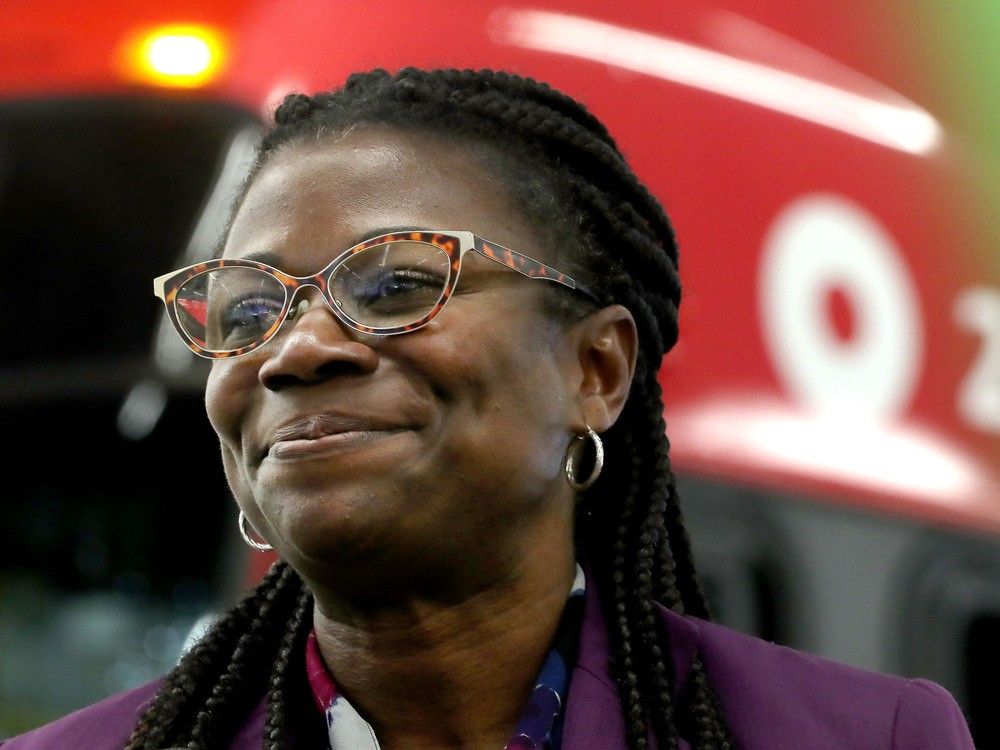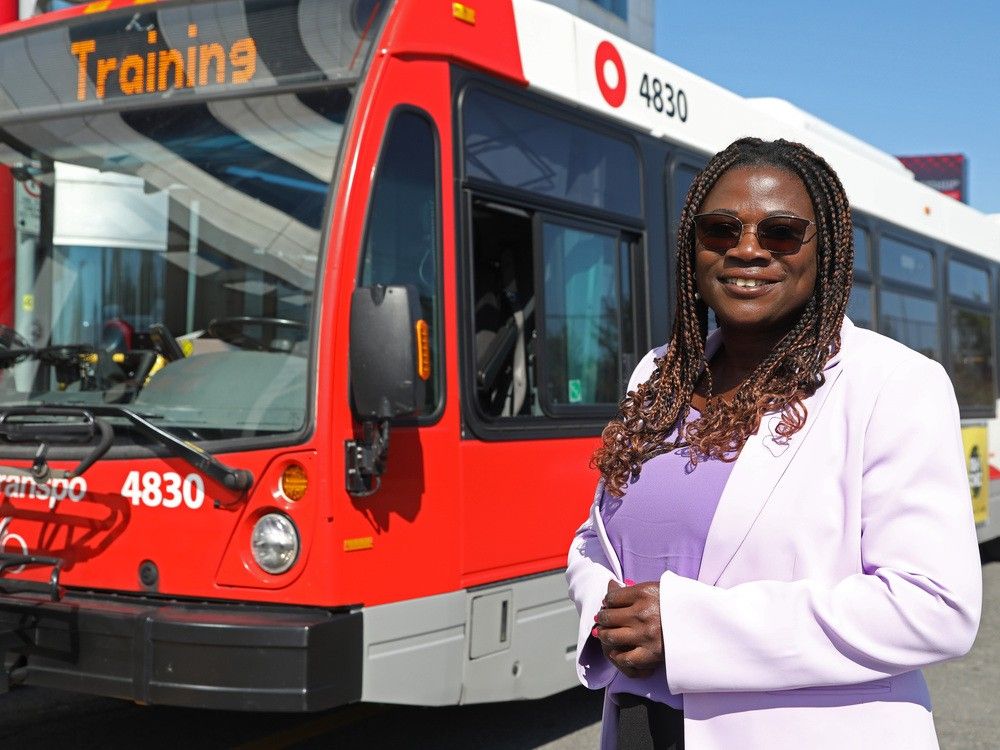Renée Amilcar took the helm of OC Transpo almost four years ago at a low point in Ottawa’s public transit history.
Shortly after her arrival in Ottawa, Justice William Hourigan’s public inquiry into the Ottawa light rail transit project concluded there were “egregious errors” and “deliberate malfeasance.” The previous summer, the LRT line was shut down for almost a week after a derailment near Tunney’s Pasture Station.
Amilcar’s own tenure as general manager of OC Transpo brought its own challenges. In the summer of 2023, Line 1 was shut down for a month after a routine inspection found that a hub on a train appeared to be leaking grease. Transit users were forced onto replacement buses.
This April, New Ways to Bus was launched, reducing, eliminating or replacing 70 routes. For some, it improved service to key destinations. For others, it added time and complexity to their commutes.
Amilcar’s last day at OC Transpo was July 18.
She is heading to Quebec City
, where she will be the president and chief executive officer of a Mobilité Infra Québec, a new transportation agency.
Q: Has Amilcar left Ottawa’s public transit in better shape than how she found it?
A: Amilcar faced almost insurmountable challenges when she arrived October 2021.
“It wasn’t like she was at the bottom of the mountain looking up. She was in a hole 100 metres deep,” said Laura Shantz, a board member with the Ottawa Transit Riders advocacy group.
“She had inherited a mess. The public was very unhappy. We’re still struggling.”
Amilcar had to live with budget constraints and political decisions, said Nick Grover, an executive member with Free Transit Ottawa, another advocacy group.
“You can’t blame her for political decisions. She’s the face of it. She gets all the flak.”
Amilcar has been lauded for her diplomatic, but decisive touch and for a collaborative and pragmatic approach. She shut down Line 1 for weeks in the summer of 2023 after a routine inspection found that a train hub appeared to be leaking grease.
The decision was made in less than 30 minutes, she would later say.
“We already knew we had a problem with the bearings. The last thing I wanted was another derailment. I’m an engineer. When you’re an engineer, when there’s an issue with safety, you have to react immediately.”
In her farewell statement to Amilcar, City of Ottawa manager Wendy Stephanson said she had always been impressed by Amilcar’s ability to be fearless.
“She’s never afraid to make a tough decision or make a decision that might not be the most popular, but in the long run it’s best for our community.”
Some have argued that public transit is in a much stronger position now than it was when Amilcar arrived in Ottawa in 2021. Line 1 performance has improved. Lines 2 and 4 are performing well. Eastern extensions of Phase 2 will open later this year, and the reliability of the bus service has improved, Mayor Mark Sutcliffe said in June.
But others argue that the jury is still out on
New Ways to Bus
, the major overhaul of bus routes launched in April that changed dozens of routes, redeploying the limited pool of buses to where ridership was higher.
Those changes included introducing new routes while retiring others and revising routes to major destinations like hospitals, universities and colleges. For some riders, it was more efficient. For others, it has resulted in commutes so convoluted that a 90-minute bus transfer window no longer works.
“They called it a consolidation, but it was a reduction,” Grover said. “Some routes got more frequency, but dozens and dozens had more transfer points.”

Q: Has transparency improved on Amilcar’s watch?
A: The need for transparency was underlined in the 2022
Ottawa Light Rail Transit Commission hearings
.
“We need to return to accountability and transparency with the people of Ottawa rather than information control and spin if the people are going to feel comfortable that their city is working for them,” said John Adair, co-lead counsel for the inquiry.
In the pre-Amicar era, Shantz pointed out, riders depended on texts from other transit users to notify them of significant issues such as a stopped train.
In the summer of 2023, when Amilcar shut down Line 1, she and other experts answered questions about progress in a daily media conference.
“She mentioned to me a number of times that she felt it was a cultural shift to be as open and transparent as possible. It has been an extremely different approach,” said Coun. Glen Gower, chair of the city’s transit committee.
“She was very hands-on. I wouldn’t be surprised if she worked every day of the week,” Gower said. “She lived and breathed transit.”
At the same time, details about technical questions, such as what actually caused the August 2021 derailment, have been sparse. (This past week, the CBC reported that Alstom, which manufactured the trains, claimed in a 2023 report that the tracks
fall short of industry standards.)
“I would like to see a future leader champion for that kind of transparency,” Shantz said. “We need, in the public interest, to know what is going on.”
One of the unknowns is whether Line 1 tracks will ultimately have to re-aligned, Shantz said. If so, the public needs to know how long will it take and the contingency plans while it is being done.
”We could face years of repair,” she said. “We need to see independent assessments of these things. Otherwise, every year we’ll be holding our breath and waiting for the next time the straw breaks the camel’s back.”
Q: Amilcar has been keen to measure the system’s performance using data. Has it been valuable?
A: OC Transpo set an ambitious goal of achieving 99.5 per cent service delivery — a measure of the degree to which planned trips are delivered — for conventional buses on its route network.
“She really believes that, if your bus and train showed up when you expect them, that’s the way to win new riders,” Gower said. “Price is less of a priority.”
There are other goals, including measuring whether trips are evenly spaced on frequent routes. The goal in that case is 85 per cent. For less frequent routes, there’s a target of 85 per cent for “punctuality,” which measures whether the bus arrives at the stop no more than one minute early or five minutes late.
Amilcar has not avoided addressing the gaps between the goal and reality. In April, she said
the 98 per cent rate for daily trips in 2024 was “not good.”
“When we deliver a 96, 97 or even 98 per cent of the service, it’s bad. It’s very bad,” she said. Those marks would be great grades in school, “but not for transit … not for buses. We need to deliver what we planned: 99.5 per cent.”
In her farewell speech to city council in June, Amilcar said OC Transpo had set the bar high.
“We aimed for 99.5 per cent service delivery, and I know, with the right funding, we will get there,” she said.
For transit advocates, “the right funding” is the big question. This year’s transit budget is bigger than ever before, but fares are increasing and service has been pared back, Grover said. For public transit to thrive, it must be made more attractive and that means spending more money, he argues.
“I can’t blame (Amilcar) for the stuff that happed. I would have liked to hear her speak out more for the things she needed. The role of general manager is limited. You’re executing a plan. It would be good if the general manager could speak out more and be bolder for what they advocated for,” Grover said.
Shantz likes to see metrics, but points out they were also available before 2017, although not on as granular a level as now, because transit vehicles are equipped with GPS.
“There are a few other things I would like to add — like the rider experience,” she said. “I would like to see a regular pulse on how people are experiencing the system. I would like to see the metrics broken down to compare rush hour to non-rush hour. That’s sometimes hidden in the numbers.”

Q: How was Amilcar’s relationship with transit union workers?
A: Cordial, but three union contracts have expired and there are negotiations ahead.
“It was a good-looking relationship,” said Noah Vineberg, president of Amalgamated Transit Unit Local 279, which represents OC Transpo bus and train operators, maintenance workers, dispatchers and fare inspectors. “I did like working with her. We had a good dialogue.”
However, Vineberg said, he has been disappointed by how little has changed. Sore points for drivers have been the scheduling of work and work-life balance. The amount of time scheduled to get from Point A to Point B was not realistic, he added.
“When it came to taking care of her people, that vision never really came to fruition,” he said.
In May,
union members said they were “met with silence”
at a city council meeting after showing up with a petition demanding higher wages and better working conditions.
“The members’ concerns were always on the back burner,” Vineberg said. “The train got all the attention, and busing was neglected. It was part of the crisis.”
Meanwhile, a recruitment campaign has failed to retain workers, he said.
OC Transpo on-boarded 800 operators within two years, Amilcar told city councillor in June. Vineberg argues that, while plenty of operators were hired, workers were being lost just as fast.
“There have been a lot of promises that have not been fulfilled,” Vineberg said. “Morale is at an all-time low. There used to be pride. The pride is gone. We’re not satisfied with the service we provide to the public.”
Amilcar did a good job for transit, Vineberg said. “She failed to look after some of her own people along the way.”
Q: What issues will the new general manager face?
A: The solution to
the LRT’s wheel woes remain elusive
. The “sustainable solution” for Line 1 is an ongoing issue, Gower said. Amilcar was hoping to see a resolution to that before she left Ottawa.
Modernizing the bus fleet is also on the radar. By 2036, the entire fleet will be electric, a major project that includes new garages and charging stations, Gower said.
But at this time there aren’t enough buses, Grover said. “Ten years ago, they had a thousand. Now they have 700, and 200 of them are in the garage.”
It’s unclear how much New Ways to Bus fallout there will be when post-secondary students return to campuses in large numbers in September. Route changes had been introduced in late April, when many students had already departed the city.
Shantz
points out that students are the best customers for transit. If they are satisfied with their experience, it will become a habit, and they might even convert their parents. “We have to make sure its working for them,” she said.
Other users are not seeing better quality of service, though, Shantz said, citing the example of Para Transpo users who can’t rely on same-day bookings.
“It’s frustrating to see service not improve in the ways it can move,” she said. “Trains are great, but they’re not the whole network. We need bread-and-butter fixes.”
Ridership is moving in the right direction, but very slowly, Shantz said. One of her concerns is whether transit users are increasing at the same rate as Ottawa’s growing population.
“I’d like to know whether we’re winning share or losing share more slowly,” she said.
The biggest question is whether residents who have foresworn public transit can be wooed back.
Grover argued that ridership rebounded after a 2008-09 transit strike, but 2011 route changes disillusioned transit users. New Ways to Bus had the same effect, he said.
“No one is returning to this. I’ve had people say, ‘I’ve finally bought a car because this is untenable.’ This will be great for Uber and Lyft.”
Our website is your destination for up-to-the-minute news, so make sure to bookmark our homepage and sign up for our newsletters so we can keep you informed.
Related
- Stuck standing, OC Transpo riders wait for benches to be reinstalled
- OC Transpo sees ‘strong ridership’ through Bluesfest



